MARIANI’S
June 1, 2008
NEWSLETTER

Tab Hunter and Roddy McDowell, circa 1958
WELCOME TO SUMMER!
NEW! Click esquire.com
to go to my new column at Esquire Magazine.
ARCHIVE: Readers may now access
an
Archive of all past newsletters--each annotated--dating back to July,
2003, by simply clicking on www.johnmariani.com/archive
SUBSCRIBE AND
UN-SUBSCRIBE: You may subscribe anyone you wish
to this newsletter--free of charge--by
clicking here.
In
This Issue
NEW YORK: DUCASSE GROUP OPENS BENOIT by John Mariani
WINE: Ornellaia by Mort Hochstein
QUICK BYTES

by John A. Curtas
Meet me at the Fair;
Don’t tell me the lights are shining, any place but there.
We can dance the
Hoochee-Coochee,
You can be my tootsie-wootsie,
If you meet me in St. Louis, Louis;
Meet me at the Fair!
Just like that song, there are parts of the St. Louis dining scene that seem to exist in a time warp. This metropolis of over two million has caught the wave of multi-cultural cooking and tapas bars to be sure, but at a certain level its dining scene remains as well worn and old school as a duck press. On two recent visits, I did not see one of those gadgets, but I did come across more tuxedoed “captains,” chafing dishes and tableside cookery than you will find anywhere west of Del Posto. At two classic St. Louis restaurants, and one new classic (by way of New York) I initially thought that these old school virtues were making a comeback, until I realized that in St. Louis they never went anywhere. And in a strange and wonderful way, they were just what I was looking for.
TONY’S
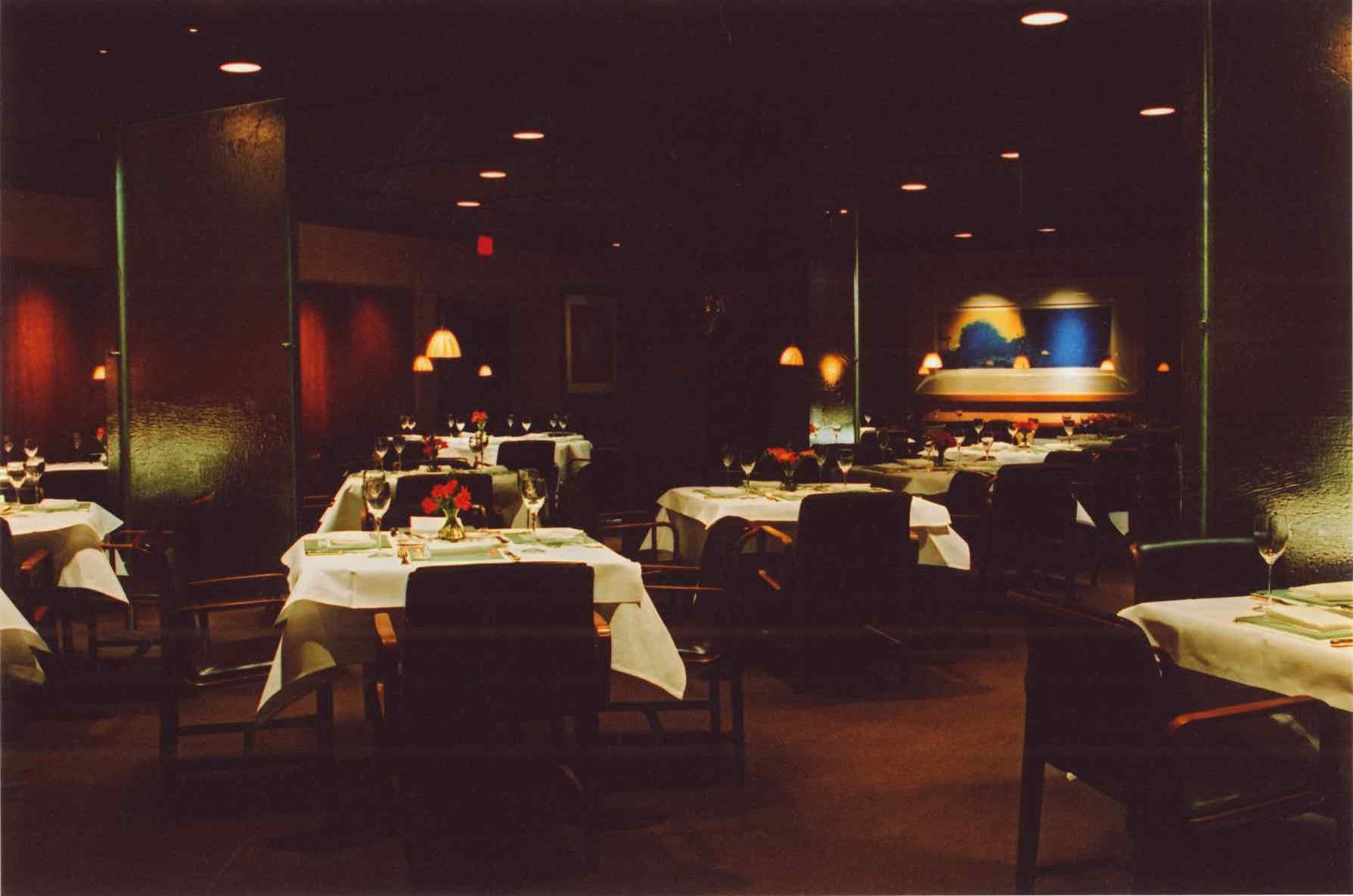
410 Market Street
314-231-7007
www.tonysstlouis.com
The long-running St, Louis hit Tony's is all about Midwestern/Italian charm--Gucci slip-ons with a Brooks Bros. suit.
It is a restaurant that knows its place in the fabric of this sedate town’s fine dining hierarchy and is more than comfortable at or near the top.
Having had only one meal there (and a solo one at that), I can hardly provide the full measure of a place, but it is obvious that when dining at Tony's certain things are a given when you put yourselves in the hands of the Bommarito family—who have operated this place since the 1970’s. For one, you will get impeccable, intensive care service. Secondly, you will be surrounded by St. Louis swells and power brokers. And finally: you will eat well-prepared, generic Northern Italian food that breaks no new ground, but is sauced and plated with care right before your very eyes.
Tony’s has been such a landmark for so long it barely needs to be mentioned that the décor in the large rectangular room is banal and understated almost to a fault. Like the patrons though, it is well heeled, comfortable and plush without being fancy. Surrounding me were families celebrating birthdays, deals being done, and even a high school couple being led through a dégustation menu by their good-humored waiter. Watching all of them having the time (and possibly the meal) of their lives couldn’t help but soften me to the charms of the place, even if some of the food didn’t live up to Tony’s reputation.
A starter of carpaccio, for example, was well constructed, although dressed with the much-maligned (for good reason) white truffle oil, and filigreed with shavings of Parmigiano-Reggiano that was not of top quality. From there, my meal proceeded to a flawless risotto with fava beans and chanterelles, and then to a main course I approached with some trepidation. I say this because ordering seafood 600 miles from the nearest body of salt water always makes me nervous. But the description of a line-caught striped bass was alluring so I took the bait. I found the vegetables burying it to be authentically overcooked, and eventually found a decent–sized chunk of this thick-fleshed species hidden under an avalanche of roasted tomatoes and mushrooms, and swimming in a tomato broth. It was folderol for a fish that didn’t need it, although mine was as pristine a fish as you could wish. Because the fillet was of such high quality, I didn’t mind it being cooked through and through, although I got the feeling looking around the room that a translucent tuna steak would be greeted with as much enthusiasm as a Chicago Cubs fan. Owner Vince Bommarito and staff
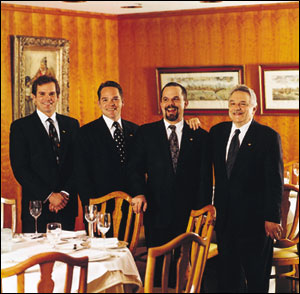
Whatever minor flaws there were with that recipe were forgiven when my attentive captain rolled the gueridon over to my table and whipped up a first-rate, sherry-infused zabaglione into shape. Like the fish course before it, and most of the dishes being served in the restaurant, it was finished and plated at the table by a constantly moving service staff that handled these duties with aplomb. All of which made me wonder why this form of intensive care cooking and service ever went out of style. Perhaps with the recent successes of CUT in Beverly Hills and Las Vegas, to say nothing of the aforementioned Del Posto, this form of service is reasserting itself—perhaps to re-establish its place beside the “food as art and chef as artist” conceit of many high end restaurants. I guess it all comes down to whether management wants to pay for extra cooks or extra captains….and how much “art” the chef needs to display on the plate.
Tony’s has probably been operating on the “if it’s not broke don’t fix it” paradigm for so long that it probably sees no need for change. But with a few upgrades and tweaks to the menu, it could keep pace with the best Italian restaurants in the country. Regardless, it will never take a back seat to any of them when it comes to heartland charm and old-fashion service.
Tony’s is open for dinner, except Sundays. Antipasti, salads and primi piatti(pastas run $8-$12; main courses are $28-41.
Dominic's on the Hill
5101 Wilson Avenue
314-771-1632
www.dominicsrestaurant.com
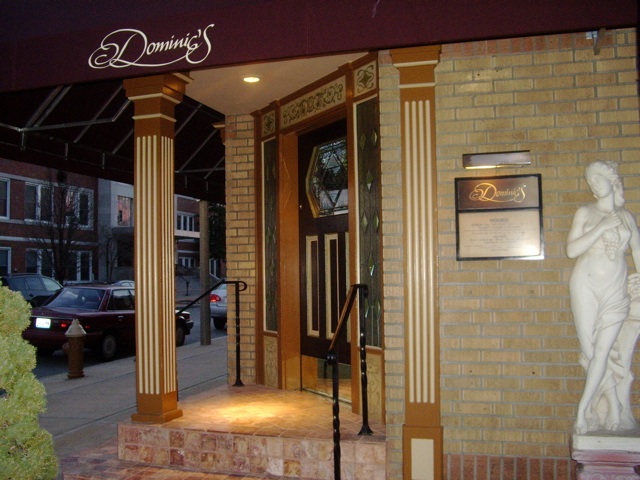 If
you think Tony’s is out-dated, then you will find
Dominic’s on the
Hill practically antediluvian. Some local foodies sneered at my
choice to dine there, but I wanted to rediscover my inner restaurant
neophyte-when the very word “chianti” conjured up exotic wine worlds I
could only dream of, and not a dissertation on what Sangiovese Grosso
clone had been pruned to appropriate D.O.C.G. standards.
Familiar, upscale, American-Italian comfort food was what I was after,
the kind I had first tasted at Mario’s in Nashville, Tennessee, and
Casa Grisanti in Louisville back in the 1970’s; Dominic’s delivered
the goods.
If
you think Tony’s is out-dated, then you will find
Dominic’s on the
Hill practically antediluvian. Some local foodies sneered at my
choice to dine there, but I wanted to rediscover my inner restaurant
neophyte-when the very word “chianti” conjured up exotic wine worlds I
could only dream of, and not a dissertation on what Sangiovese Grosso
clone had been pruned to appropriate D.O.C.G. standards.
Familiar, upscale, American-Italian comfort food was what I was after,
the kind I had first tasted at Mario’s in Nashville, Tennessee, and
Casa Grisanti in Louisville back in the 1970’s; Dominic’s delivered
the goods.From the Italianate statuary out front to the “best hits” menu, this place is a throwback that wins you over with the friendly earnestness of the staff and the solid cooking of good ingredients. Dominic and Jackie Galati have owned this little corner of St. Louis’s famous Italian neighborhood since 1971 and cater to a clientele who remember when pappardelle with mushrooms, salmon with shrimp sauce, and grilled portobellos were cutting edge.
Tables are well spaced and comfortable, the ambiance is civilized, and once again, tableside cooking is the rule, not the exception. Waiters and captains (not to mention the ever-present Dominic) wheel them about and sauce such tried-and-true standards as Dover sole amandine and tournedos Rossini as if nori foams and foie gras ice cream had never been heard of. It is doubtful that, in this humble burg, they have been.

Stewed involtini of thin-sliced eggplant started our meal, covered with the ubiquitous red “sauce” that also napped some al dente (remember what romance that phrase once held?) rigatoni all' Amatriciana that could’ve benefited from a bit less sauce, a bit more heat and substantially more guanciale or pancetta. For some reason, a cardinal dining out rule of mine was violated when both my dining companion and I opted for remarkably similar veal dishes. Hers was al limone with capers and mushrooms, while I couldn’t resist the comfort of a true saltimbocca. Both were superb, and went splendidly with a meaty Talenti 2001 Brunello di Montalcino.
Osso buco alla Dominic Just as they were being plated (at tableside of course), a tiny detail appeared that highlights the attention to detail this kitchen gives to its food. Without even noticing, a waiter had brought us small plates containing perfectly trimmed and sautéed carrots, zucchini and potato slices. It was a trifle to be sure, but one that communicates why this cuisine, and Dominic’s, is so popular.
For dessert we couldn’t resist another zabaglione, since St. Louis might be the American capital of this labor-intensive dessert. Hard-working Mid-westerners seem proud to make it (not always the case in Italy), and their versions are less Marsala-drenched than those I’ve found in Venice and Milan, but no less satisfying. Dominic’s version was perfectly fine but maybe an egg-yolk less rich than Tony’s.
Everything about Dominic’s seems timeless, from the modest bar, to the subdued lighting to the personal attention every customer receives. It is as far from with-it cuisine as you can get, but to aging boomers (like me) who received their first taste of fine dining at places like it decades ago, it takes you back to a place in your gourmet education that you didn’t realize you missed so much.
Dominic’s on the Hill is open for dinner nightly. Appetizers run from $6-12, pastas $8-16, and main courses $21-41.
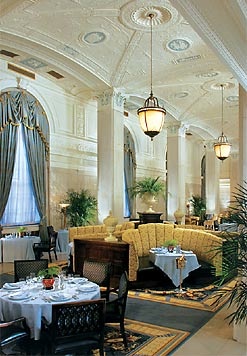 An
American Place
An
American PlaceRenaissance Grand Hotel
822 Washington Avenue
314-418-5800
www.anamericanplacestl.com
Larry Forgione (below) sounds like a guy who runs an Italian restaurant, but his muse has always been the authenticity of true American recipes and home-grown products. He opened the seminal An American Place on Lexington Avenue in New York City in 1983,and is as responsible as anyone in America for the recognition and revitalization of our natural bounty-and the bringing of same to our restaurant tables. Along with Alice Waters, Bradley Ogden, et al, he was a champion of eating local long before most foodies knew what a farmstead cheese was. Three years ago he located An American Place to the old lobby of the Statler Hotel (now the Renaissance Grand),in downtown St. Louis, and it is no understatement to say the food is as homey, interesting, and well-executed as anything he ever did in New York.
New York’s loss has been St. Louis’s gain, since it makes perfect sense to re-locate an icon of American cookery to this bastion of Americana. Eating local is all the rage, and carbon footprints don’t get much smaller than Ozark forest mushrooms trucked in for an intense, creamy bisque. Likewise, a stew of smothered Amish chicken chunks, surrounding semolina gnocchi (really more like small round polenta cakes), sprinkled with fried sage leaves and "tobacco jus" (?), isn’t looking across any ocean for inspiration or ingredients. When viewed from such a perspective, there was really no better place than the heartland of America for An American Place to find a home.
Joshua Galliano is Forgione’s Chef de Cuisine, and he presents a humble Butter Bibb lettuce salad as a composed pile of sparkling greens, napping them with a local blue cheese dressing and spiced
 local
nuts.
It is a simple but elegantly dressed salad and further proof that
great chefs know how to make humble ingredients sing. The menu
doesn’t overdo the provenance of its products, but comforts
locals with a duo of Prairie Grass Farm lamb, Missouri grass-fed
beef, and a list of twenty-one local farms from which the restaurant
sources its provisions. I’m sure the shrimp in my shrimp and
grits entrée didn’t jump onto to my plate from the Mississippi
River (just a mile down the street), but they were as intensely
shrimp-y
as any Santa Barbara prawn and sat atop creamy Anson Mills grits,
bathed in a red wine/hamhock sauce, providing perfect comfort food for
a chilly evening.
local
nuts.
It is a simple but elegantly dressed salad and further proof that
great chefs know how to make humble ingredients sing. The menu
doesn’t overdo the provenance of its products, but comforts
locals with a duo of Prairie Grass Farm lamb, Missouri grass-fed
beef, and a list of twenty-one local farms from which the restaurant
sources its provisions. I’m sure the shrimp in my shrimp and
grits entrée didn’t jump onto to my plate from the Mississippi
River (just a mile down the street), but they were as intensely
shrimp-y
as any Santa Barbara prawn and sat atop creamy Anson Mills grits,
bathed in a red wine/hamhock sauce, providing perfect comfort food for
a chilly evening.The wine list is (surprise!) all-American, and complements this gutsy cuisine perfectly. Our bottle of Loring Pinot Noir, Brousseau Vineyard, 2005, strutted plenty of terroir and fell pleasantly short of being another overly fragrant, new world fruit bomb. With a menu full of such compelling items as duck fries with mustard cream, braised cockscombs, and coriander marinated quail with cocoa jus (paired with Missouri as well as California wines on the tasting menu), I can’t wait to return.
An American Place is open for dinner only, Tuesday-Saturday. Appetizers start at $7.50-$8.50, main courses $15-34, and tasting menus are $69 and $90.
Since 1995, John A. Curtas has been commenting on the Las Vegas food scene and reviewing restaurants for Nevada Public Radio. He is also the restaurant critic for KLAS TV, Channel 8 in Las Vegas, and his past reviews can be accessed at KNPR.org.
~~~~~~~~~~~~~~~~~~~~~~~~~~
NEW YORK CORNER
by John Mariani
Benoit
60 West 55th Street
646-943-7373
www.benoitny.com
Photos by Michael Piazza
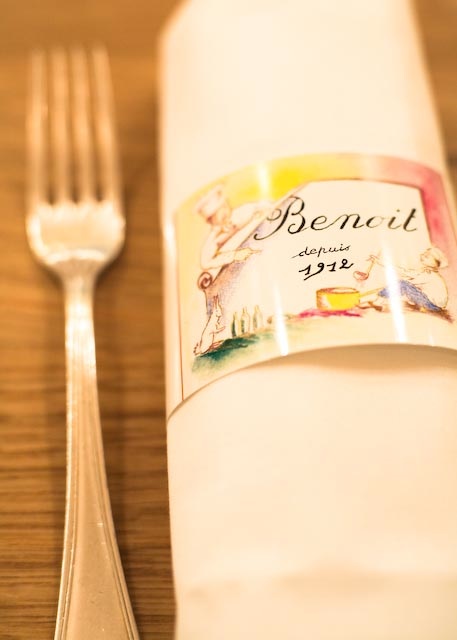 The
closing last year of what had been
the venerable chef Jean-Jacques Rachou's LCB Brasserie and previous to
that a reincarnation of the original La Côte Basque
saddened a great many people, not least because Rachou, now in his
'70s, had for so long been a fixture in NYC's dining scene. So the
reconfiguration of the premises by Alain Ducasse Group as Benoit had
additional appeal because Rachou was invited back into the kitchen to
oversee a couple of his classic recipes, like quenelles and cassoulet.
The
closing last year of what had been
the venerable chef Jean-Jacques Rachou's LCB Brasserie and previous to
that a reincarnation of the original La Côte Basque
saddened a great many people, not least because Rachou, now in his
'70s, had for so long been a fixture in NYC's dining scene. So the
reconfiguration of the premises by Alain Ducasse Group as Benoit had
additional appeal because Rachou was invited back into the kitchen to
oversee a couple of his classic recipes, like quenelles and cassoulet.The Ducasse Group, which already opened the posh Adour this spring in the St. Régis Hotel (after closing his Alain Ducasse NY restaurant in the Essex House), along with a restaurant in London's Dorchester Hotel and Paris' Eiffel Tower, already operates the historic Benoit bistro, which opened in Paris' 4th Arrondissement at 20 Rue Saint-Martin in 1912; they took it over from the longtime caretakers, the Petit family.
I cannot say how much the Group changed the original decor of Benoit Paris, for I haven't been back since they took over in 2005. I do recall tile floors, carved dark wood, brass railings, copper bars, engraved glass, stiff linens, and high prices--even when the US dollar was a lot stronger. It long ago became a chic place to dine, and it is one of the few actual bistros in Paris to have a Michelin star. Today a 3-course à la carte dinner runs 60€ (about $90).
Benoit NY has a similar feeling to the original, but then again, it has a very similar feeling to LCB Brasserie, and many of the dishes here now were staples at LCB--mostly classic bistro dishes that strike no new ground, which might be expected, but neither is the menu all that interesting. The thing of it is, not only are the offerings no improvement upon the menu that had been in place at LCB, but it doesn't add anything to the wide range of bistros already pumping away in NYC, which include La Goulue, Orsay, Café Loup, Café Luxembourg, Jean-Claude, Le Réfuge, Le Veau d'Or, and many others; nor does it have the panache of more inventive bistros like JoJo, Nice Matin, Payard Bistro, db Bistro Moderne, or the new Bar Boulud. The menu is not even as interesting as Ducasse Group's own, very lovable Aux Lyonnais in Paris, itself a bistro now in its ninth decade.
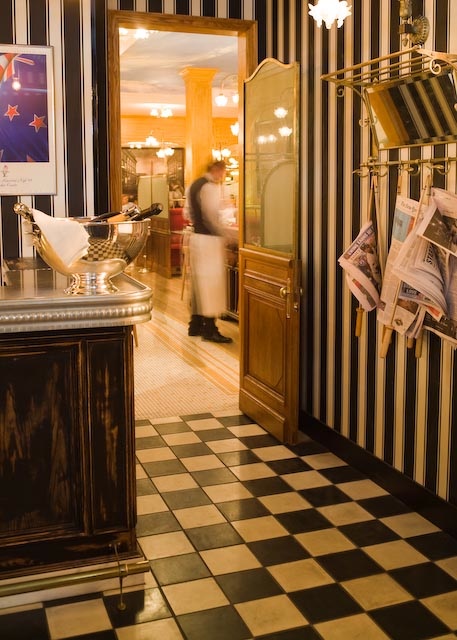
Benoit's cooking, under Chef Sébastien Rondier runs from wholly delicious to rather humdrum, and, on the basis of two recent visits, the kitchen does not yet seem in synch. On both occasions the deep fryer was out of commission, so--Mon Dieu!--no frites! Still, there is plenty to delight you if you crave straight-arrow French bistro cuisine.
You enter, as you do in Paris, through a revolving door, and to your right is a station with lovely and very cordial hostesses; to the left is a handsome bar with a light menu and an array of aperitifs (though having but a single beer on tap, Kronenbourg, is odd). The main dining room is done up in golden-blond wood, tile floors, and bright lighting (the sconces evoke those in Paris), all the better to see who's coming and going. At the moment it's a mix--West Siders, French tourists, and a lot of people who need help getting in and up from their table. The service staff and kitchen get the food out at a good pace, even when the place is packed, comes out at a good pace. You are presented with gougères cheese puffs--not hot enough on two occasions.
The zinc and wood tables do not, alas, have tablecloths (they do in Paris), and though this is a bistro, the wineglasses are cheap, the silverware mismatched. Arnaud Démas is busy stocking the winelist, which for the moment is top heavy with expensive bottlings.
On my first visit I ordered the charcuterie--no match for the splendid array that Bar Boulud offers--so I had little reason to order it a second time. One of the oddities on the menu is a hard-boiled egg with mayonnaise, which I haven't seen in ages and don't much care to again. Absolutely wonderful was a kind of millefeuille of veal tongue--rich, fatty, delicious. Lobster bisque was silky, with a good portion of lobster meat, and the onion soup gratinée was textbook perfect--dark, robust, with just the right amount of cheese to sink down, bubble up, and take on golden brown color. It's the best in NYC.
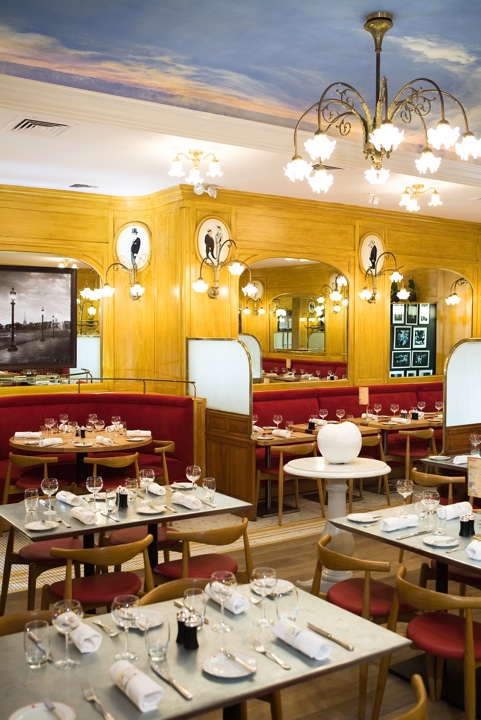 Those
Rachou quenelles of pike with
sauce Nantua were, as ever, incredibly rich--one or two bites and you
may
roll your eyes; they will also make you giddy with pleasure. A
friend who had never had them was swooning on the first morsel.
Halibut, as it so often is,
was very dull, the fish itself without much flavor, the texture
slightly overcooked, The lamb chop, though of fine enough quality, was
just a
lamb chop, but the potatoes dauphinois
brimming
with cream and a nice
crusty browning. As for the cassoulet,
served in a ceramic dish,
the meat and beans were nicely cooked, but it was
too soupy and lacked the requisite crusted top that by tradition you
should have to tap with a spoon to break through. It was a real
disappointment.
Those
Rachou quenelles of pike with
sauce Nantua were, as ever, incredibly rich--one or two bites and you
may
roll your eyes; they will also make you giddy with pleasure. A
friend who had never had them was swooning on the first morsel.
Halibut, as it so often is,
was very dull, the fish itself without much flavor, the texture
slightly overcooked, The lamb chop, though of fine enough quality, was
just a
lamb chop, but the potatoes dauphinois
brimming
with cream and a nice
crusty browning. As for the cassoulet,
served in a ceramic dish,
the meat and beans were nicely cooked, but it was
too soupy and lacked the requisite crusted top that by tradition you
should have to tap with a spoon to break through. It was a real
disappointment.We ordered duck à l'orange to see how that old canard would fare in the hands of a modern chef. The opinion: pretty well, certainly not cloyingly sweet as the dish used to be in the past, but certainly nothing to get excited about again. The biggest downer one day at lunch was roast chicken, served for two, which also came in a cooking dish, perfumed with herbs--far too many, for the meat was suffused with it, and the skin was not at all crisp. Never would I judge every chicken that comes out of a kitchen by one bird on one day, but it's hard to imagine how they could have missed the mark so widely.
Desserts, by Jean-Sebastien Magat, were very welcome, including a large portion of many profiteroles with vanilla ice cream and a lush chocolate sauce, and a wonderful baba au rhum, moist but not overpowered with liquor.
At this point Benoit is jammed with curiosity seekers and a good passel of regulars from LCB Brasserie and, before that, La Côte Basque. Benoit is very trendy at the moment--it has the Ducasse name on it (one NYC newspaper reported seeing Ducasse dining at another restaurant the same night Benoit opened). Things have to settle down. Nevertheless, I think the food was better and the menu certainly more varied when this was LCB.
What is amazing is that Benoit's prices are so very, very reasonable, with appetizers $9-$19 (for foie gras) and main courses $19-$29. The eggs go for a buck apiece. (one
Benoit is open Mon.-Sat. for lunch, Mon.-Fri. for breakfast, Sun for lunch, and nightly for dinner.
~~~~~~~~~~~~~~~~~~~~~~~~~~~~~~~~~~~~~
NOTES FROM THE WINE CELLAR
Ornellaia,
40 Years Later
By Moth Hochstein
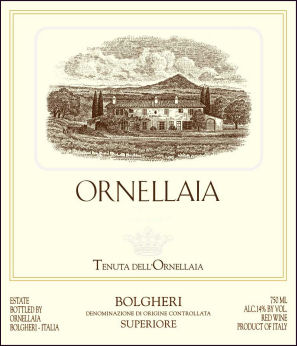 It
was not long ago, as winemaking history goes, that Tuscan
winemaking was primarily Chianti and most of it was produced in
the hills and valleys near Florence in
central Italy. The coastal region around
Bolgheri known as the Maremma was largely neglected and its
winemaking potential remained a wild frontier until the late
1970¹s when winemakers from classic Chianti and Piedmont regions
began digging into undeveloped fields.
It
was not long ago, as winemaking history goes, that Tuscan
winemaking was primarily Chianti and most of it was produced in
the hills and valleys near Florence in
central Italy. The coastal region around
Bolgheri known as the Maremma was largely neglected and its
winemaking potential remained a wild frontier until the late
1970¹s when winemakers from classic Chianti and Piedmont regions
began digging into undeveloped fields.
The first winemaker of note in the Maremma was Mario Incisa
Della Rocchetta who bred horses at the family¹s Tenuta San Guido
in Bolgheri. In 1944 he planted vines for a wine that was
to make history two decades later when, in 1968, he issued his
initial commercial release, a blend of 85% cabernet sauvignon and
15% cabernet franc he called Sassicaia,
which means "place with a lot of rocks." It was the
first of the Super-Tuscans, the wines that broke the rules for
Chianti wines, which had always been native Italian
blends based on sangiovese.
At first designated simply Vino da tavola, the lowest level of
Italian wine, they soon were recognized as the best Tuscan reds,
proving that DOC ranking was no guarantee of quality.
Its closest rival is Ornellaia, from land long held
by the Antinori family. The first Ornellaia from the 1985 vintage was
released in 1988. Guided by Lodovico Antinori with input from
leading Italian winemakers and California's André
Tschelistchef, Ornellaia quickly established itself as the
principal rival to Sassicaia, although it does not use the same blend,
and the two have remained at the top of the Bolgheri hit parade
ever since.
They are gems, prizes for collectors and the
darling of auctioneers. I was fortunate to
attend a limited vertical tasting of Ornellaia, marking its 20th
anniversary in late March, which Alessandro Lunardi, U.S. marketing
director, proudly staged at the posh Fifth avenue
imported menswear shop, Ermengildo Zegna; it was the first New
York showing of the 20005 Ornellaia, along with the 1995
and 1988, to show the wines' aging ability, and its second wine,
Le Serre Nuove, a blend of 50% merlot, 35% cabernet
sauvignon, 10% cabernet franc and 5% petit merlot.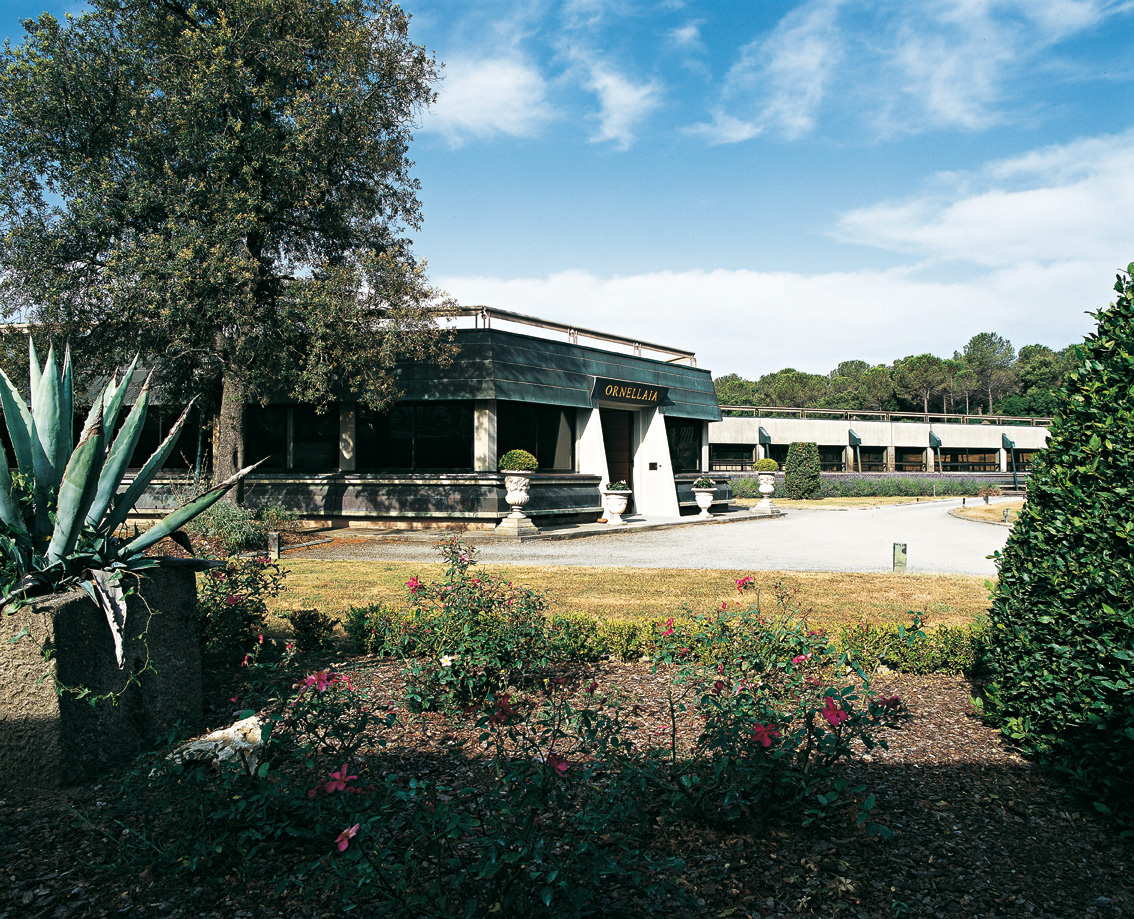
There is a common thread of lush, dark- colored fruit and
suppleness among all the Ornellaia wines, and I saw amazingly
little difference in quality between that stunning Serre Nuove
and its more highly regarded siblings. The newest of the
lot, the 2005, made from 60% cabernet, 20% merlot, 15% cab franc
and 5% petit verdot, seems destined for a long and pleasurable
life. It has the classically elegant Ornellaia nose, deep
ruby red color, and hints of coffee and spice, even, tobacco, at
this young age. It is well balanced, and the finish just goes on
and on.
At 13 years of age, the 1995 is now ready to drink.
It is the product of a late spring and a cold and wet growing season,
marked by an uncharacteristically wet August. The difficult
harvest was salvaged by more agreeable weather from mid-September
through harvest into early October. From a tough year the winemakers
produced a sturdy and agreeable red, but one lacking
the grace of those the preceded and followed it. The 1995 is 76%
cabernet, 18% merlot and 5% cab franc.
My favorite Ornellaia was the 1988. A
classically elegant, lush wine marked by the scent of
cocoa, dark cherries and concentrated fruit, the wine is
well balanced, velvety on the palate and perfect for drinking
now. It has wonderful depth and focus with great complexity and
flavor--a simply outstanding wine that is easily the equal of the
finest Bordeaux growths.
That quality of wine does not come cheap. If you
have to ask, as they say, you can¹t afford it. For the
record, however, recent asking prices for the 1995 ranged from
$109 to $135 and for the 1988, $199. The 2005 will list at $184
and will go on sale in May with just 2,500 cases allotted to the
United States.
~~~~~~~~~~~~~~~~~~~~~~~~~~~~~~~~

AND THE MEATPACKERS
STOOD SILENT,
THEIR BUTCHER HOOKS AND CARVING
KNIVES IN HAND
In New York City The Veggie Pride
Parade took place this month in Manhattan's Meatpacking District before
ending at
Washington Square Park. Costumed participants included bride and groom
Penelo Pea Pod and Chris P. Carrot (left),
who
exchanged vows and asked
observers to "Give Peas a Chance" and "Go Vegetarian!"
FOOD WRITING 101: DECONSTRUCTIONISM IS NOT A GOOD METHOD FOR RESTAURANT REVIEWING

“Recently, the dryness of a filet of striped bass was soon forgotten thanks to the wintry gratifications to be found underneath it; flageolet beans, guanciale stew, and leek fondue. Occasionally, the intricacies seem a little overdone. Romero has a radical way with Brussels sprouts, peeling them like cabbages and tossing the leaves with oil and slivered almonds. Ingenious, certainly, but the sprouts, deprived of their tight, balled crunch, emerge as a sorry and laborious simulacrum of potato chips.”—Leo Carey, “Tables for Two: Smith’s,” The New Yorker (March 17, 2008).
QUICK BYTES
* From June 1-July 31 in Chicago and Schaumburg, IL, Shaw’s Crab House is celebrating
Maine Lobsters with specials such as such as Rocky’s Lobster Deal
($34.95 pp), a 3-course family style lobster dinner, and a chance
to win a Rockin’ Lobster Dinner Party for you and 14 friends. Visit
www.shawscrabhouse.com.
• On June 4, the Bel-Air Hotel in Bel-Air, CA, will
hold a Zaca Mesa winery dinner for $125 pp. Call 310.472.5234. Visit
www.hotelbelair.com
* From now until June 17 Tony May and Marisa May invite you
to join them in toasting to the 20th anniversary of San Domenico NY, featuring Executive
chef Odette Fada bringing back the restaurant’s most popular and
acclaimed specialties from the restaurant’s opening menu at the
original price--$55--along with a complimentary glass of Spumante Brut.
Call 212-265-5959.
* In Washington, D.C. Taberna del Alabardero’s Executive
Chef Dani Arana and Sommelier Gustavo Iniesta have launched a 2008 wine
dinner series entitled Tasting Spain. On the first Monday of every
month through October, the restaurant will host a wine dinner with a
specialized theme, highlighting wines from various Spanish regions and
pairing them with the region’s authentic cuisine. The next wine dinner
on Monday, June 2nd, is themed "Nuevos Vino, Vieja Cocina" (New
Wines, Old Cuisine), for which Taberna has collaborated with Bacchus
Importers and Ole Imports, which imports more than 100 different
Spanish wines from 20 Denominación de Origens. $100 pp
Call 202-429-2200. visit www.alabardero.com.
• From June 3-20 NYC’s Grand Central Oyster Bar celebrates
the arrival of “nieuwe maatjes” herring from the Netherlands, presented
in association with the Consulate General of the Kingdom of the
Netherlands and Heineken Premium Light. Admission free: Food and
beverage by consumption: Dutch Herring prices: $7 per. Call
212-490-6650; http://www.oysterbarny.com.
* On June 3 All’Angelo in
Los Angeless will feature a “Night in Friuli,” with food and wines from
that region. $ 145 pp. Call 323-933-9540.Visit
www.allangelo.com.
* On June 5, 2008, the Southern
Food and Beverage Museum (SoFAB) in New Orleans opens with
The Eat, Drink, SoFAB! Gala, with board members Jeff Tunks with
Acadiana in Washington D.C.; Louis Osteen of Louis's in Pawley's
Island, SC; Regina Charboneau of Twin Oaks Plantation in Natchez,
MI; and more. Sponsor tix $125 pp and Supporter tix $60 per
person. Visit southernfood.org.
• * On June 10 North Texas restaurant industry members will gather at The Milestone Culinary Arts Center for this year's Greater Dallas Restaurant Association dinner to benefit the Texas Restaurant Association Political Action Committee. Inspired by this year's Spanish theme, the 5-course meal features Spanish-influenced dishes from Dallas' chefs, incl. John Maas, Tower Club; Chris Ward, Mercury Grill; Sharon Van Meter, Milestone Culinary Arts Center; Janice Provost, Parigi; Cherif Brahmi, Maguire's. $125 pp. Call 214-671-4372.
* On June 13, Viet
Bistro and Lounge in Chicago will host a Summer Wine and
Spirits
Tasting and Seminar with Sommelier Rashed Islam, along with Shane
Salois of Cream Wine Co. Chef/Owner Dan Nguyen will prepare
Vietnamese appetizers. $30 pp. Call 773-465-5720.
* From June 16-20 NYC’s Aquavit celebrates its annual
Herring Week by offering several different selections of this
Scandinavian delicacy in the restaurant’s Café. Lunch: $27,
Dinner: $48 . Call 212-307-7311.
* On June 17 Angelina’s
in Tuckahoe, NY, will feature a “Wine Tour of Italy,” a 5-course dinner
with regional Italian wines. $75 pp. Call 914-779-7319.
* From June 20-22nd Trapp
Family Lodge in Stowe,
VT, hosts the 10th Annual Stowe Wine and Food Classic, featuring
silent and live wine auctions, cooking demos, wine seminars, and more.
Featured guest chefs incl. former personal chef to Oprah, Tom Bivins
from the New England Culinary Institute, Tony Campos of New England
Cooks, and Trapp Family Chef Jürgen Spagolla., who will prepare
the Gala Dinner Dance on Sat. $150 pp. Trapp Family Lodge Deluxe rooms
start at $224 per night. Visit www.stowewine.com. Call
(800) 826-7000.
* From June 22-24 Chef Mike Lata of FIG Restaurant in Charleston, SC,
will travel to Tennessee in June as part of the 2008 food and wine
lineup at Blackberry Farm.
Joining Lata for the weekend will be guest vintners Heidi and Ted Lemon
from Littorai Wines in Sebastopol, CA. Call 800-648-4252.
For more information, visit www.blackberryfarm.com. For more
information about FIG restaurant, call 843.805.5900 or visit
www.eatatfig.com.
Everett Potter's Travel Report:

~~~~~~~~~~~~~~~~~~~~~~~~~~~~~~~~~~~~~~~~~~~~~~~~~~~~~~~~~~~~~~~~~~~~~~~~~~
Eating Las Vegas is the new on-line site for Virtual Gourmet contrinbutor John A. Curtas., who since 1995 has been commenting on the Las Vegas food scene and reviewing restaurants for Nevada Public Radio. He is also the restaurant critic for KLAS TV, Channel 8 in Las Vegas, and his past reviews can be accessed at KNPR.org. Click on the logo below to go directly to his site.
~~~~~~~~~~~~~~~~~~~~~~~~~~~~~~~~~~~~~~~~~~~~~~~~~~~~~~~~~~~~~~~~~~~~~~~~~~~
Tennis Resorts Online: A Critical Guide to the World's Best Tennis Resorts and Tennis Camps, published by ROGER COX, who has spent more than two decades writing about tennis travel, including a 17-year stretch for Tennis magazine. He has also written for Arthur Frommer's Budget Travel, New York Magazine, Travel & Leisure, Esquire, Money, USTA Magazine, Men's Journal, and The Robb Report. He has authored two books-The World's Best Tennis Vacations (Stephen Greene Press/Viking Penguin, 1990) and The Best Places to Stay in the Rockies (Houghton Mifflin, 1992 & 1994), and the Melbourne (Australia) chapter to the Wall Street Journal Business Guide to Cities of the Pacific Rim (Fodor's Travel Guides, 1991). THIS WEEK: A Report on The Four Seasons Jackson Hole. Click on the logo below to go to the site.

~~~~~~~~~~~~~~~~~~~~~~~~~~~~~~~~~~~~~~~~~~~~~~~~~~~~~~~~~~~~~~~~~~~~~~~~~
MARIANI'S VIRTUAL GOURMET NEWSLETTER is published weekly. Editor/Publisher: John Mariani.
Contributing Writers: Robert Mariani,
Naomi
Kooker, Suzanne Wright, John A. Curtas, Edward Brivio, Mort
Hochstein, Suzanne Wright. Contributing
Photographers: Galina Stepanoff-Dargery, Bobby Pirillo. Technical
Advisor: Gerry
McLoughlin.
Any of John Mariani's books below
may be ordered from amazon.com by clicking on the cover image.
 My
newest book, written with my brother Robert Mariani, is a memoir of our
years growing up in the My
newest book, written with my brother Robert Mariani, is a memoir of our
years growing up in the For those of you who don't think of the Robert and I think you'll enjoy this very personal look at our --John Mariani |
 |
 |
 |
 |
 |
 |
© copyright John Mariani 2008
